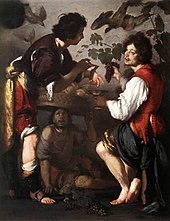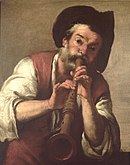Bernardo Strozzi
Bernardo Strozzi (* 1581 or 1582 in Genoa ; † August 2, 1644 in Venice ) was an important Italian painter of the early Baroque . Since he belonged to the Capuchin order , he was also called il Cappuccino or il Prete Genovese ("the priest from Genoa").
Life
His exact year of birth is not known, various later documents and early biographers contradict each other in the fact that he was born either in 1581 or 1582. His parents were Pietro Strozzi and Ventura Pizzorno. Bernardo had a sister Ginetta, who was married to an Onofrio Zino for the second time.
Only after the death of his father, who had planned a scientific course for him, was Bernardo able to complete a regular training course as a painter, which he completed first with Cesare Corte and between 1596 and 1598 with Pietro Sorri from Siena . At the age of 17, Bernardo decided to live as a monk in the Capuchin convent of San Barnaba in his hometown of Genoa, which he entered around 1599. After about nine years, so in 1608 or 1609, he left the monastery to support his mother and as a secular priest to live, and lived at first in a few kilometers from Borzoli removed.
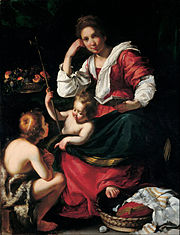
Strozzi began - probably while still in the monastery - as a painter of saints and received his first public commissions for Madonna pictures in churches in Rapallo and Borzoli. In 1610 the 28-year-old lived temporarily in Milan with the family of the Spanish Count Andrea Manrique de Lara, possibly as a private tutor.
In January 1614 he was back in Genoa and sought to supplement his income with the help of engineering activities at the port . At the same time Strozzi established himself as a painter and was occasionally called in as an expert in order to assess the value of the paintings of other artists and to set a price.
From 1618 he lived in the Contrada degli Orti di Sant'Andrea, where he bought a house with apartments and workshops on December 5, 1620. On October 16, 1619, he had already founded a workshop, together with the spice dealer Bastiano De Ferrari, who ran the business. From 1620 Giovanni Gerolamo Ghisolfi had the exclusive right to trade in Strozzi's paintings.
One of his greatest patrons in Genoa was Giovan Carlo Doria , for whom he had already painted 25 paintings by 1621 alone. In the Palazzo of Giovanni Stefano Doria (a cousin of Giovan Carlo) Strozzi created ceiling frescoes around 1618 , including the triumph of David and allegorical figures.
The two Dorias also gave him the vault frescos with the vision of St. Dominikus in the choir of the Church of San Domenico (Genoa), for which he was rewarded with 700 silver scudi in September 1622 ; however, these paintings were almost completely lost when the church was destroyed in 1825, as were his paintings for the oratory of the Church of San Tommaso. For the church of the Genoese monastery of Santa Teresa he created a picture of the transfiguration of St. Teresa of Ávila (today: Palazzo Bianco , Genoa) in 1622 , probably in connection with the canonization of the saints mentioned.
Strozzi also worked for Battista and Filippo Centurione, among other things he painted some ceiling frescos for the latter in his villa in Sampierdarena . One of his best-known works from the early 1620s is the Madonna with Child and Little John the Baptist in the Palazzo Rosso in Genoa (signed). Probably through Filippo Centurione he also received the commission for the Madonna of Justice ( M. della Giustizia , around 1624) for the Sala dei Supremi Sindicatori in the Palazzo Ducale of Genoa; the picture is now in the Louvre (Paris).
Some authors believe that Strozzi stayed in Rome in the spring and summer of 1625 , as he was recommended to the Roman Capuchin monastery in a letter from the Ligurian provincial of his order; however, a stay in Rome is not guaranteed.
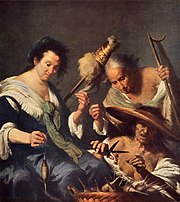
In 1625 Strozzi got into trouble through a series of litigation and charges. First of all, in June of that year he complained about the damage that his paintings suffered from the dust of a neighboring lime workshop; several of his painters colleagues supported him and testified for him. Shortly thereafter, Strozzi was sued by a dissatisfied customer and had to pay him compensation . At the same time there were difficulties with Luigi Centurione, in whose palazzo on Strada Nuova the painter had started with a fresco decoration in August 1623, but which he broke off prematurely after a violent dispute with the client. Centurione sued Strozzi for breaking his contract. In this case, Marco Antonio Doria and the painter Giuseppe Catto, who had worked in parallel with Strozzi on the decoration, stood up for the painter.
In this situation, Antonio Guido Castiglione , the procurator of the tax authorities , finally turned up and reported Strozzi on December 12, 1625, for allegedly painting in a way that was dishonorable for his clerical status , since he was in public places his financial advantage and work on mundane topics. In the subsequent process, not only several painters and Strozzi's art dealers testified, but also his doctor Giovanni Agostino Barbano and his patron Filippo Centurione. Strozzi, for his part, pleaded for acquittal and demanded compensation from the prosecutor Castiglione.
Three years after the trial was over, in June 1629, four witnesses testified for Strozzi and confirmed that he was an honorable painter; on May 8, 1630, his doctor Barbano and the painter Antonio Travi also testified that his health was poor.
Strozzi's reputation as a painter does not seem to have suffered any major damage, at least he created altarpieces for several churches in Genoa at the end of the 1620s: for the Chiesa della SS. Concezione, the Chiesa di Nostra Signora della Misericordia (today Chiesa dei Sordomuti) and for Sant 'Ambrogio.
After his mother's death, he was obliged to return to the monastery, so Strozzi tried in 1630 to change from his previous order to the Congregation of the Augustinian Canons of the Lateran ( canonici regolari lateranensi ), because they had assured him that he would continue his profession may exercise freely. Although the Capuchins had already been given to their agreement, gave him the archiepiscopal e Curia of Genoa in agreement with the Doge Andrea Spinola on August 25, 1630 a warrant to come. Strozzi petitioned the government of the Republic of Genoa and was granted several respite. In September – October 1631 there was a trial in which Strozzi was also accused of preventing the capture of a Giovanni Maria Scaglioso. Eventually the painter was forced to return to the Capuchin order (1631–32). Since he could not continue his painting workshop like this, his sister Ginetta entrusted it to his closest collaborators Giuseppe Catto and Giovanni Francesco Cassana.
Bernardo Strozzi tried several times in vain to escape from the convent and, in desperation, turned to the Signoria of Venice on July 20, 1633 with the request for a letter of protection with a guarantee for a safe stay in the lagoon city. He finally managed to escape after he was allowed to leave the monastery at short notice to visit his sister. In October 1635 at the latest he was in Venice and declared Ginetta to be his representative in Genoa.
He flourished in Venice and his art reached its peak. He turned increasingly to portraiture and painted, among others, the Doge Francesco Erizzo , the Cardinal Federico Corner , the composer Claudio Monteverdi , and the poet and librettist Giulio Strozzi (father of Barbara Strozzi ).
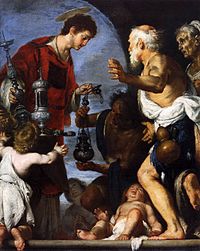
As early as 1635 he received an official commission for a ceiling painting in the Biblioteca Marciana with an allegory of sculpture . In the following year he created a ceiling painting for the Ospedale degli Incurabili alongside Padovanino , which has only been partially preserved (including in the Accademia , Venice; and Bozzetti in the Uffizi , Florence). Towards the end of the 1630s, among other things, important altarpieces were created for the Venetian churches of San Benedetto and San Nicolò da Tolentino . Bernardo Strozzi also painted still lifes , together with some specialists such as Simone del Tintore or Pietro Paolini.
Strozzi also improved his income in Venice through engineering activities: he invented a system to regulate the flow of water in the lagoon , for which he received a payment of 1,000 scudi on December 23, 1642.
On August 1, 1644, after a short illness, Bernardo Strozzi made his will and passed away a day later in his apartment in the Contrada di Santa Fosca.
Appreciation
Bernardo Strozzi is considered to be one of the most important exponents of 17th century colorism . His work is a combination of numerous stylistic influences: in his work he incorporated suggestions from Tuscan masters such as Giovanni Battista Paggi and Aurelio Lomi , and from works by Barroccis and Rubens , which he could see early in the churches of Genoa. At times he followed the then modern tenebrism , as used by the more elegant Caravaggists Bartolomeo Cavarozzi or Simon Vouet . In addition, there were influences of the Flemings Anthonis van Dyck and Pieter Aertsen . Strozzi processed all of this into his very own, unmistakable style. Typical for him are imaginative compositions with monumental figures of a certain softness. A humorous trait pervades his genre scenes in particular .
After moving to Venice, the influence of the Venetian tradition in the succession of Veronese , Tizian and Tintoretto , as well as Domenico Fetti and Johann Liss , resulted in a "highest increase in his painterly qualities" - with a loose and fragrant brushwork and a lightened, luminous palette that influenced painters such as Sebastiano Ricci and Tiepolo in the late baroque period .
Strozzi was also a wonderful portraitist and left behind some very beautiful still lifes.
Picture gallery
Sleeping child , Residenzgalerie , Salzburg
Lute player , approx. 1630–35, Kunsthistorisches Museum , Vienna
Portrait of a Holy Bishop (San Gerardo Sagredo?), 1633–35, Art Institute of Chicago
The gardener , Maison d'Art, Monaco
Portrait of the poet Giulio Strozzi , Castle Museum, Güstrow
The interest penny , 1630s, Szépművészeti Múzeum , Budapest
Allegory of Fama , ca. 1635–36, National Gallery , London
The prophet Elias and the widow of Sarepta , around 1640, Kunsthistorisches Museum , Vienna
Works (selection)
- Christ carrying the cross , Museo diocesano, Chiavari
- Madonna Hodegetria , San Maurizio di Monti near Rapallo
- Madonna of the Rosary , Parish Church (parrocchiale) of Borzoli
- Alexander crowns Abdolominos , Fuji Art Museum, Tokyo
- St Catherine of Alexandria , Wadsworth Atheneum Museum of Art, Hartford
- St. Catherine of Alexandria , Anton Ulrich Museum, Braunschweig
- St. Caecilia , The Nelson-Atkins Museum of Arts, Kansas City
- Transfiguration of St. Teresa of Avila , 1622, Palazzo Bianco, Genoa
- Madonna and Child and Little John the Baptist , Palazzo Rosso, Genoa (signed, 1620s)
- Ceiling frescoes (including Dido and Aeneas ) in the Villa Centurione, Sampierdarena.
- Madonna in Glory with St. Teresa and the Blessed Salvatore da Horta , private collection
- The Pifferaio , 1624-25, Palazzo Rosso , Genoa
- The gardener , Maison d'Art, Monaco
- St. Teresa of Avila in Glorie (today: Palazzo Bianco, Genoa)
- Madonna and Child and St. Felice da Cantalice , Chiesa della SS. Concezione, Genoa
- Madonna and Child and Saints Giovannino and Laurentius , 1629 (signed and dated), Chiesa dei Sordomuti, Genoa
- Madonna with Child and Saints Clara, Ambrosius and Erasmus , before 1629, Sant 'Ambrogio, Genoa Voltri
- Lute player , around 1630, Kunsthistorisches Museum , Vienna
- The parable of the interest penny , around 1630, several versions a. a. in: Alte Pinakothek , Munich
- The cook ( Genoa , Palazzo Rosso )
- Annunciation , approx. 1631, (originally for the Conservatorio Interiano) in the collection of the Banca Carige, Genoa
- * The Healing of Tobias ( Saint Petersburg , Hermitage ), around 1635
- Portrait of Giulio Strozzi , 1635 (signed and dated), Ashmolean Museum, Oxford
- Claudio Monteverdi , Galleria dell'Accademia, Venice
- The Doge Francesco Erizzo , Galleria dell'Accademia, Venice; and Kunsthistorisches Museum, Vienna
- Cardinal Federico Corner , Ca 'Rezzonico, Venice
- Portrait of the procurator Giovanni Grimani , Palazzo Barbaro, Venice
- St. Sebastian healed by pious women , San Benedetto, Venice
- St. Christopher with St. Sebastian and Rochus , parish church ( parrocchiale ), Almenno San Salvatore
- Rebecca and Eliezer at the fountain , Gemäldegalerie Alte Meister , Dresden
- St. Laurentius distributes the church treasure to the poor , around 1640, San Nicolò da Tolentino, Venice
- Assumption of the Virgin , 1639–42 (originally for San Domenico, Genoa) San Matteo, Laigueglia
- The sermon of John the Baptist , 1644, Kunsthistorisches Museum , Vienna
- Banquet at Simon , Accademia , Venice
- Annunciation of Mary , approx. 1644, two versions, u. a. in: Szépművészeti Múzeum , Budapest ,
literature
- Strozzi, Bernardo , in: Lexikon der Kunst , Vol. 11, Karl Müller Verlag, Erlangen, 1994, pp. 190 f
- Daniele Sanguineti: Strozzi, Bernardo, detto il Prete genovese o il Cappuccino , in: Dizionario Biografico degli Italiani , Volume 94, 2019, online on Treccani (Italian; accessed on June 9, 2020)
Web links
- Works by Bernardo Strozzi at Zeno.org .
- Overview of the works and their storage locations (in English)
Individual evidence
- ↑ a b c d e f g h i j k l m n o p q r s t u v w x y z aa ab ac ad ae af ag ah ai aj ak al am an ao ap aq ar Daniele Sanguineti: Strozzi, Bernardo, detto il Prete genovese o il Cappuccino , in: Dizionario Biografico degli Italiani , Volume 94, 2019, online on Treccani (Italian; accessed June 9, 2020)
- ↑ a b Strozzi, Bernardo , in: Lexikon der Kunst , Vol. 11, Karl Müller Verlag, Erlangen, 1994, p. 190 f
| personal data | |
|---|---|
| SURNAME | Strozzi, Bernardo |
| ALTERNATIVE NAMES | il Prete Genovese; il cappuccino |
| BRIEF DESCRIPTION | Italian painter |
| DATE OF BIRTH | 1581 |
| PLACE OF BIRTH | Genoa |
| DATE OF DEATH | August 2, 1644 |
| Place of death | Venice |

